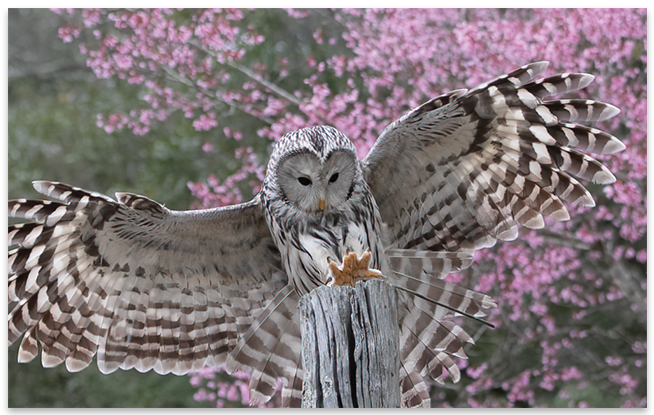Learn why the center is needed to protect birds of prey more than ever

A red-tailed hawk serves as a winged ambassador for the Avian Conservation Center, which celebrates its 30th anniversary with its Wingspan benefit on October 24.
Valerie Sprinkel had been waiting for her next patient to arrive. When the large cardboard box secured with dog leashes was delivered to the door of the Avian Medical Clinic, the technician carefully untied the ropes, peeled back the flaps, and lifted out an enormous shorebird, gently holding the shovel-like beak closed and noting its drooping wing. “Pelicans get themselves into predicaments,” explains Stephen Schabel, director of education at the Avian Conservation Center, adding that the birds can become habituated enough with humans to remain close but unaware of life-threatening dangers such as swimming through an oil slick in the harbor or flying too close to trucks.
Of the nearly 14,000 birds that have been treated by the center since it opened 30 years ago, most have run afoul of humans: They’ve been hit on the road, shot, become tangled in nets, or sickened by eating from a food chain that starts with poisoned vermin. “We had a great horned owl that was seemingly bleeding from its skin,” Schabel recalls. “It had eaten a rat that we suspect had eaten d-Con, and it was dying from it.”
Back in 1991, executive director Jim Elliott recognized the need for a facility to treat and rehabilitate birds and founded the Charleston Raptor Center. That mission has since expanded to become the Avian Conservation Center, which consists of the Avian Medical Clinic, another medical facility designed to respond to birds contaminated in oil spills, and the popular educational outreach Center for Birds of Prey. Since the early 2000s, the complex has been tucked into a 152-acre conservation easement in Awendaw about 10 miles north of Mount Pleasant. There, facilities are home to 120 birds, including owls, hawks, eagles, falcons, storks, and vultures.

A Ural owl comes in for a landing.
The South Carolina Oiled Bird Response Facility, built in 2007 with mitigation funds from the 1999 Star Evviva spill off the Carolina coast, is the only center of its kind in the Southeast and can also be used for isolated incidents such as the vulture that got caught in the oil trap of a fast food joint.
In addition to injured patients, another half of the center’s avian population has been bred for conservation. They serve as ambassadors, educating humans as to why it’s important to protect their habitat. “It’s the easiest job in the world—to teach with a live bird on your glove,” Schabel says.
Before COVID, the Center for Birds of Prey attracted up to 17,000 visitors a year and another 30,000 through outreach programs. Late this summer, the center reopened to limited visitors. It’s been a favorite field trip destination and hosts photographer days so locals can play paparazzi with raptors ready for close-ups.

(Left to right) Director of education Stephen Schabel holds an American kestrel; Avian clinic technician Valerie Sprinkel inspects an injured pelican.
The lessons are important ones. Birds serve as “sentinels,” and their overall health forecasts what’s to come for people and the environment. “The contacts with humans are getting worse,” says Schabel. “In 1991, we had eight patients. In 2019, we had more than 1,000, and it’s averaging that now. Is it because there are more people, or are more people aware that we’re here?”
He has his eyes on the kestrels, the smallest North American falcon. “Their population is declining,” he says. “It’s telling us the effects of our actions.” Schabel has also seen troubling deaths in other species, including bald eagles, and blames factors such as invasive plant species and euthanized pets dumped in landfills, their bodies filled with chemicals. “Birds in general are not doing that great,” Schabel says, adding that there are three billion fewer in North America today than in 1970. “The big picture is we have to pay attention.”